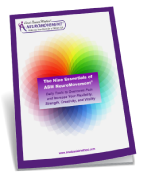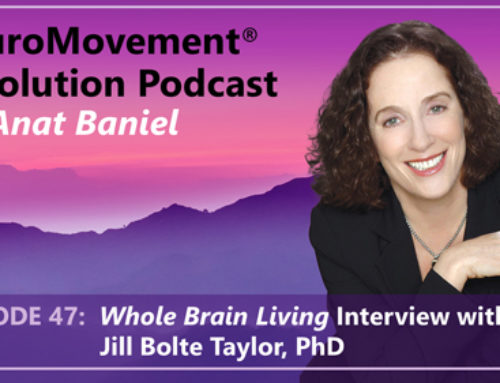The Fitness Myths That Hold You Back, and How to Succeed: Myth 2
The No Pain, No Gain Myth

Last week, we introduced the “Training Your Muscles” myth. This week we are going to talk about the “No Pain, No Gain” myth.
In the beginning, like most of us, Gary put way too much force into what he was doing. To get himself in shape, he started weight lifting, climbing steeper hills, and taking much longer walks … But it seemed that the more effort he put into these workouts, the more tight and rigid he became, and his back pain and stiffness worsened. —Excerpt from Move Into Life
How many of you have had this kind of experience of going gung ho when deciding to get fit or when starting a new fitness program just to find yourself injured and in pain? If you are like most of us, it didn’t take long for you to become disheartened and quit, even if you were told to “work through the pain.”
Fitness Myth 2: The No Pain, No Gain Myth
One of the biggest fitness resolution killers is pain. It is a harmful myth that is deeply ingrained in our fitness culture and beyond.
The question we need to ask: Is pain, or more importantly, forcing through pain, necessary for increasing our athletic ability and reaching new heights of fitness, performance, and health?
My answer is a resounding NO!
Pain is the body’s alarm system that informs us that we are in the process of harming ourselves, that we need to back off and need to do something differently. Forcing through pain actually can have long-term negative outcomes to our body and our fitness level. So much so that recent brain research shows that chronic pain results in loss of brain connections to the painful area—a loss in what is called brain “mapping.”
For example, when musicians or athletes have pain in their shoulder and they keep forcing painful movements in that arm, they not only suffer, but gradually lose some of their dexterity and strength in that area. Their performance begins to deteriorate and over time, if the pain persists, they have to give up.
 From my experience working with thousands of people (from athletes to musicians to moms to computer users) suffering from back, shoulder, neck, and other kinds of pain, almost always the pain is the result of poorly-organized movement.
From my experience working with thousands of people (from athletes to musicians to moms to computer users) suffering from back, shoulder, neck, and other kinds of pain, almost always the pain is the result of poorly-organized movement.
As described in my previous post “The Fitness Myths That Hold You Back, and How to Succeed: Myth 1,” what needs to be done is to provide the brain with new information with which it can create new patterns of well-organized movement. Almost without exception, when movement is well organized, the pain disappears, and strength and flexibility increase—we become more fit.
In addition to the first Essential we discussed previously—Movement with Attention—there are two additional Essentials that are powerful antidotes to pain and limitation.
The Slow Essential
The first one is Slow. Fast, you can only do what you already know. Fast does not give you an opportunity to feel what you are doing and for your brain to discover alternative and better ways to move. Doing an exercise fast from the very beginning, or doing it while in pain, will only groove in more deeply the existing brain patterns of pain and limitation.
Try this 10-minute NeuroMovement video lesson and experience the Slow Essential. You can bring slow to any movement you do.
The Subtlety Essential
Subtlety, the next Essential, provides the brain with new information it needs to improve the organization of your movement and relieve you of pain, thus opening up the path for greater fitness. Subtlety means that you intentionally reduce the force with which you do the movements or exercise you are engaged in. When you move with as little effort as you can master, your brain can notice what it is that you are doing and how you are doing it, and immediately use this information to improve the way you move. Any well-organized, harmonious movement is pain-free, leading to greater strength and skill, and is always very pleasurable to do.
And guess what? When moving feels good, you move more and get more fit.
Try this 10-minute NeuroMovement video lesson and experience the Subtlety Essential.
In Gary’s case:
I told Gary that he would need to cut way back on his exercise. Instead of lifting the heaviest weights he possibly could, I asked that he lift very light weights for a while—and not climb more steep hills for a few weeks….
…I had him do some very simple floor exercises. Through these exercises, I guided and encouraged him to reduce the force with which he moved. He discovered that when he did this, his body moved much better, with greater ease and pleasure…
Gary continued lifting lighter weights as part of his new regimen…He enthusiastically reported that the pain and stiffness were gone and that at the end of the day he had so much energy that he was getting things done around the house that he’d been putting off for years … that he was also feeling younger and more vital than he’d felt in over a decade. —Excerpts from Move Into Life
These three Essentials—Movement with Attention, Slow, and Subtlety—may feel counterintuitive. However, practicing these Essentials will not only help you get rid of pain, it will actually increase your fitness level very quickly. Give them a try for a week or two and see what happens.
Anat Baniel
Related Resources and Research
Baniel A. 2009. Move into Life: The Nine Essentials for Lifelong Vitality. New York: Harmony Books
The brain uses information it acquires through perceiving differences to create new connections between different brain cells; this capacity is calleddifferentiation. Differentiation is a fundamental process underlying all forms of life.
Prasad KN. 1980. Regulation of differentiation in mammalian nerve cells. Plenum, NY. Scientists are able to measure and track the process of differentiation as it is taking place in the brain.
Hebrew University of Jerusalem. 2007. Scientist observes brain cell development in “Real Time.”
ScienceDaily, May 29.
Mizrahi A. 2007. Dendritic development and plasticity of adult- born neurons in the mouse olfactory bulb. Nature Neuroscience 10(4): 444- 52.
Those connections come together in complex, dynamic, responsive, and continuously evolving patterns. For research describing development in terms of complex dynamic systems, see:
Smith LB, Thelen E. 2003. Development as a dynamic system. Trends in Cognitive Sciences 7(8): 343- 48.
Thelen E, Smith LB. 1996. A Dynamic Systems Approach to the Development of Cognition and Action. Cambridge, MA, MIT Press.
Fast we can do only what we already know: See Libet B, Gleason CA, Wright EW, and Pearl DK. 1983. Time of conscious intention to act in relation to onset of cerebral activity (readiness potential): The unconscious intention of a freely voluntary act. Brain 106: 623- 42.
Going slowly allows the brain to figure out what in its existing repertoire may be useful, allowing the new skill to emerge. Bernstein NA. 1996. On exercise and motor skill, In Latash ML, Tuvey MT, eds. On Dexterity and Its Development. Translated by ML Latash. Mahwah, NJ: Lawrence Erlbaum.
See also Thelen E, Smith LB. 1996. A Dynamic Systems Approach to the Development of Cognition and Action. Cambridge, MA: MIT Press.
“Thinking is the same fundamental process in the brain as organizing movement.” Merzenich M. April 2009. Lecture on brain plasticity to students in the Anat Baniel Method Professional Training Program. Anat Baniel Method Center, San Rafael, CA.





